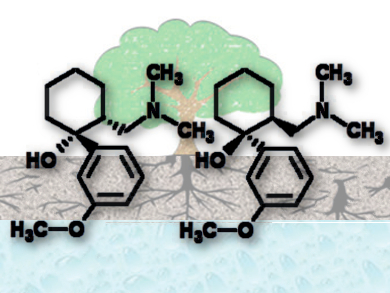Painkiller Found in Plants
Tramadol, a synthetic opioid component of the painkiller tramal, was surprisingly identified in 2013 as a natural product of Sarcocephalus latifolia, a tree found in Cameroon. Scientists from Germany and Cameroon now refute this finding in the journal Angewandte Chemie. By determination of the 14C content, for example, they established that the tramadol found in plants is in fact anthropogenic and introduced by off-label use of the drug. Serious health and environmental problems may occur as a consequence.
Natural Product or Man-Made Contamination?
In Northern Cameroon, tramadol is used less as a pain reliever or antidepressant but rather as a doping agent to allow both animals and humans to work in temperatures above 40 °C during the dry season. Contaminated soil and water samples were therefore not surprising. Or does tramadol come from trees? A team headed by Michael Spiteller has now conclusively answered this question.
By using the radiocarbon method usually used for age determination, the researchers proved that the tramadol in Cameroon’s environment is of synthetic origin. If the tramadol had recently been produced by a plant, it would mirror the current 14C content in our atmosphere. Industrially produced organic molecules made from fossil-fuel-derived starting materials contain no 14C because it has long since decayed. The tramadol found in the environmental samples investigated was free of 14C and is therefore unambiguously synthetic. A further piece of evidence is that the Sarcocephalus latifolius plants that the researchers grew from seeds from a botanical collection contained no tramadol. However, if the plants were grown with tramadol-containing water, the plants took up the drug without metabolizing it further.
High Environmental Concentrations
In order to evaluate the persistence of tramadol in the environment and the extent of its misuse, Spiteller and his colleagues from the TU Dortmund, Germany, and the University of Maroua, Cameroon, tested the tramadol content of soils, groundwater, surface water, and well water, as well as S. latifolius. In some cases, these tests revealed alarmingly high concentrations, even in plants other than S. latifolia. High concentrations of tramadol and one of its powerful metabolites were found in public wells. “We found particularly high levels of contamination in the dry season when water levels were low in a river bed in downtown Maroua in North Cameroon,” says Spiteller. “This area is inhabited by many homeless people, who use the contaminated water for drinking.”
“Now that we have provided unambiguous proof that the environment in Cameroon is significantly contaminated with synthetic tramadol, urgent measures must be taken to reduce the off-label use of tramadol,” states Spiteller. This requires the prohibition of street-market sales of prescription drugs. “In addition, further research is needed to assess the long-term side effects of tramadol in humans, animals, and the environment.”
- Synthetic Origin of Tramadol in the Environment,
Souvik Kusari, Simplice Joel N. Tatsimo, Sebastian Zühlke, Michael Spiteller,
Angew. Chem. Int. Ed. 2015.
DOI: 10.1002/anie.201508646


